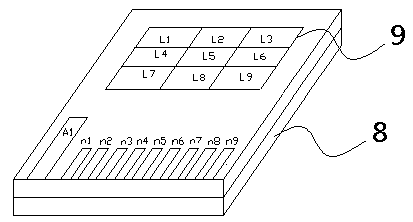Fluorescence spectrum detection device for pesticide residue
A fluorescence spectrum and detection device technology, which is applied in the field of pesticide residue fluorescence spectrum detection devices, can solve the problems of cumbersome sample pretreatment, difficult to meet the rapid detection of pesticide residues on site, etc., and achieves portable design, simple pretreatment method, and reduced system cost effect
- Summary
- Abstract
- Description
- Claims
- Application Information
AI Technical Summary
Problems solved by technology
Method used
Image
Examples
Embodiment 1
[0033] The principle of this embodiment is similar to that of the traditional method, and optical fiber is used for optical transmission. The difference is that in this embodiment, an optical filter group 7 and a photosensitive element 5 are arranged behind the coupling lens 4 to replace the original spectrometer. The selection of a suitable filter in the filter 7 obtains the measured spectral intensity of the corresponding pesticide residue, and according to the comparison between the measured spectral intensity and the threshold value, it is determined whether the pesticide residue exceeds the standard.
Embodiment 2
[0035] like Figure 4 As shown, this embodiment is a compact design structure of the detection device in Embodiment 1. The working principles of the two embodiments are similar, and the main difference is that this embodiment does not use expensive optical fibers, but passes the light emitted by the uniform light integrating rod 2 through the focusing lens 3 arranged in front of the uniform light integrating rod 2 , directly form electric light source excitation on the vegetable stems and leaves 10 to be tested, and the fluorescence generated by the pesticide residues passes through the coupling lens 4, and enters the photosensitive element 5 after being filtered by the filter sheet group 7, and the characteristic peak intensity of the fluorescence measured by comparison With the threshold intensity, qualitatively determine whether the pesticide residues exceed the standard.
PUM
 Login to View More
Login to View More Abstract
Description
Claims
Application Information
 Login to View More
Login to View More - R&D
- Intellectual Property
- Life Sciences
- Materials
- Tech Scout
- Unparalleled Data Quality
- Higher Quality Content
- 60% Fewer Hallucinations
Browse by: Latest US Patents, China's latest patents, Technical Efficacy Thesaurus, Application Domain, Technology Topic, Popular Technical Reports.
© 2025 PatSnap. All rights reserved.Legal|Privacy policy|Modern Slavery Act Transparency Statement|Sitemap|About US| Contact US: help@patsnap.com



